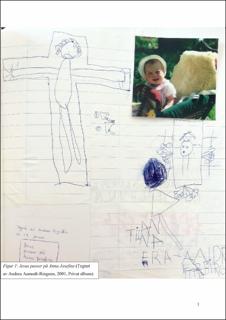| dc.contributor.advisor | Løkken, Ingrid Midteide | |
| dc.contributor.author | Aamodt-Ringøen, Andrea | |
| dc.date.accessioned | 2021-09-25T16:26:36Z | |
| dc.date.available | 2021-09-25T16:26:36Z | |
| dc.date.issued | 2021 | |
| dc.identifier | no.uis:inspera:82370538:2853933 | |
| dc.identifier.uri | https://hdl.handle.net/11250/2783028 | |
| dc.description.abstract | I denne studien diskuterer jeg barns sorg og sorgprosesser. Målet med studien er å øke læreres kunnskap og kompetanse om barn i sorg og lærerens rolle i møte med disse. Barn sørger på ulike måter, og det er derfor viktig at læreren har forståelse for dette og lar barnet sørge på sin måte. Lærere bør dermed ha kunnskap om hvordan elever kan sørge. Eksempler på dette kan være gjennom lek og tegning, gjennom å snakke, eller gjennom utagerende- eller «innagerende» atferd. Som vi vet, spiller skolen en stor rolle i elevers sorgprosesser. Lærers relasjon med den rammede eleven, og fortrolighet med tema, er her da essensielt for sorgarbeidet.
Jeg har benyttet et kvalitativt, fenomenologisk forskningsdesign, og videre tatt i bruk metoden life story. Informantene har fått fortelle sin historie uten forstyrrelser fra forskers side. Informantene har fortalte sin bakgrunnshistorie og hvordan tapet har formet dem til å bli den de er i dag som individ. Mine fem informanter fortalte også om hvordan skolen tok dem imot og hva de vektla for å bidra i sorgprosessen. Avslutningsvis fortalte informantene om hva de mener skolen burde gjort og hvordan de mener skolen i dag bør møte elever i sorg.
Resultatene viser at fire av informantene har fått ulik hjelp fra skolen, og grunnet at de er forskjellige og sørger ulikt, har de i mer eller mindre grad tatt imot og utnyttet hjelpen. Det er viktig å få bearbeidet sorgen, samtidig er det essensielt for en hjelper å vite at dette kan gjøres på mange måter. Barnet i sorg må om mulig selv få si sin mening om hvordan de vil bli tatt imot og hjulpet over tid. Det kommer også frem at de informantene som har hatt en særlig viktig person som hjalp dem gjennom den verste sorgperioden, har klart seg noe bedre enn de som ikke har hatt «denne ene». Det viktigste informantene kommer frem til er det å faktisk bli sett og anerkjent i sorgen.
I drøftings- og diskusjonsdelen settes studiens resultater sammen med teori, og her diskuteres blant annet informantenes bakgrunn og tap, samarbeid med hjemmet, og skolens rolle. Sistnevnte er delt opp i tre; kontaktlærers rolle, helsesykepleiers rolle, og rollen til medelever. Til sist i drøftingskapittelet ser vi på hvordan informantene sier de har det i dag, og hva de vektlegger som viktig. Tiden leger nok ikke alle sår, men ved at sorgen bearbeides sammen med andre, kan sorgen deles og dermed bli mindre. | |
| dc.description.abstract | In this study, I discuss children's grief and grieving processes. I aim to increase teachers' knowledge and competence about children in mourning and the teacher's part here. Children grieve in different ways, and it is therefore important that the teacher shows understanding and lets the child grieve in their own way. Teachers then need to have knowledge of how students can grieve. Examples of this can be through play and drawing, through talking, or through acting out or having internalized behavior. As we know, school plays a big role in students' grieving processes. The teacher's relationship with the affected student, and familiarity with the topic, are then essential for the grief work.
I have used a qualitative, phenomenological research design, and further used the life story method. Here the informants tell their story with little interruption from the researcher. The informants have told their background and how the loss has shaped them to become who they are today. My five informants also talked about how the school met them and what they emphasized to contribute to the grieving process. In conclusion, the informants talked about what they think the school should have done and how they think the school today should do in meeting students in mourning.
The results show that four of the informants have received different help from the school, and due to the fact that they are different and provide different care, they have to a greater or lesser extent received and utilized the help. It is important to process the grief, at the same time it is essential for a helper to know that this can be done in many ways. If possible, the child in mourning must be able to express their own opinion about how they will be met and helped over time. It also appears that the informants who have had a particularly important person who helped them through the worst period of grief have fared somewhat better than those who have not had "the one". The thing the informants recognize as most important is to actually be seen and recognized in their grieving process.
In the discussion, chapter five, the results of the study are put together with theory, and here the informants' background and loss, collaboration with the home, and the school's part are discussed. The latter is divided into three parts; the role of the contact teacher, the role of the health nurse, and the role of fellow students. Lastly in the discussion chapter, we look at how the informants say they feel today, and what they emphasize as important. Time probably does not heal all wounds, but by processing the grief with others, the grief can be shared and thus become less. | |
| dc.language | nob | |
| dc.publisher | uis | |
| dc.title | Skolens rolle i barns sorgprosesser | |
| dc.type | Master thesis | |
